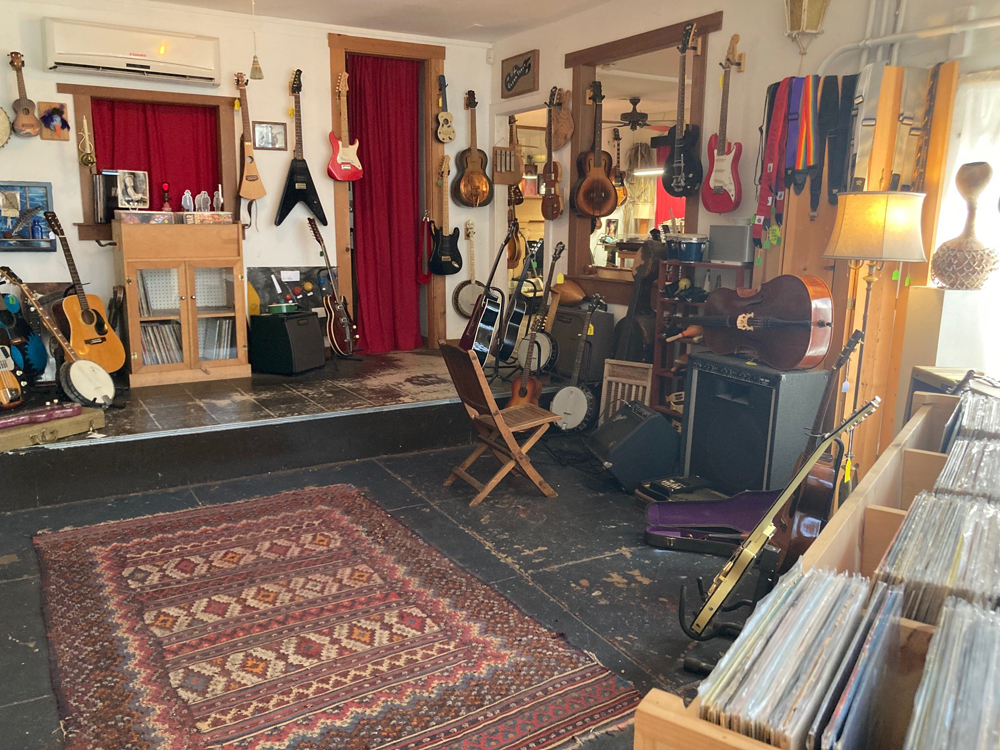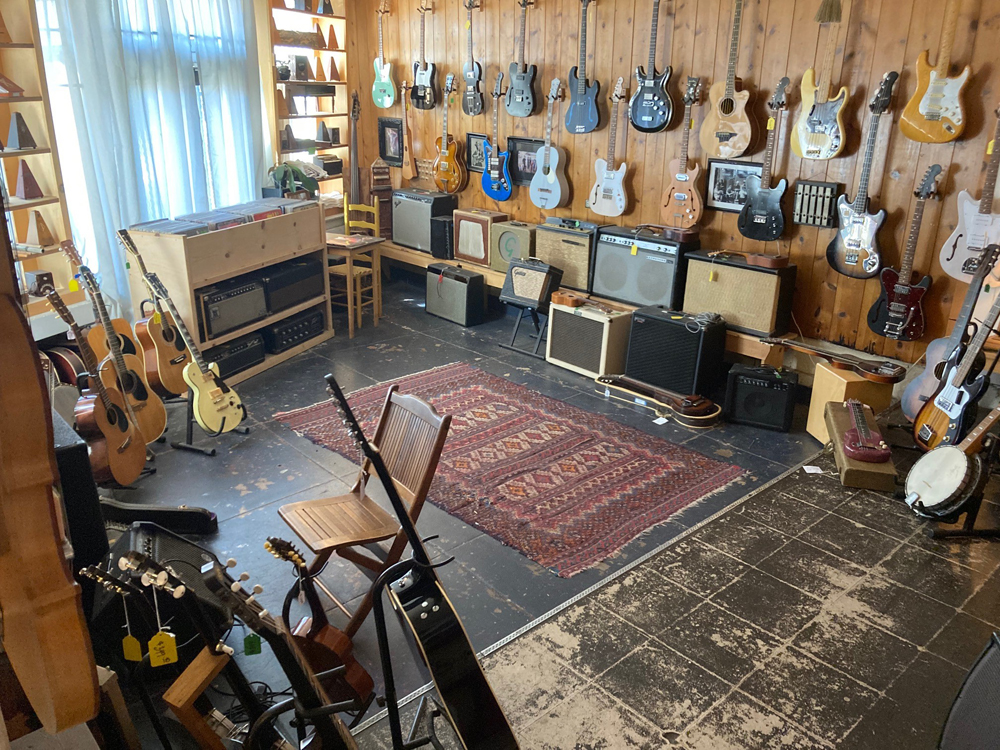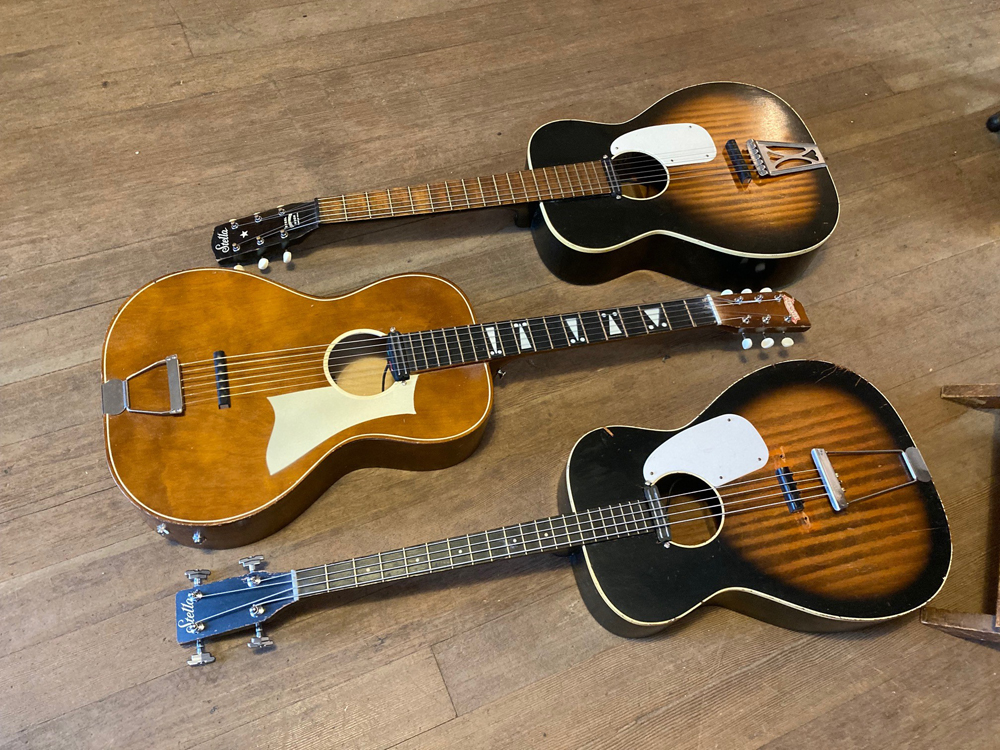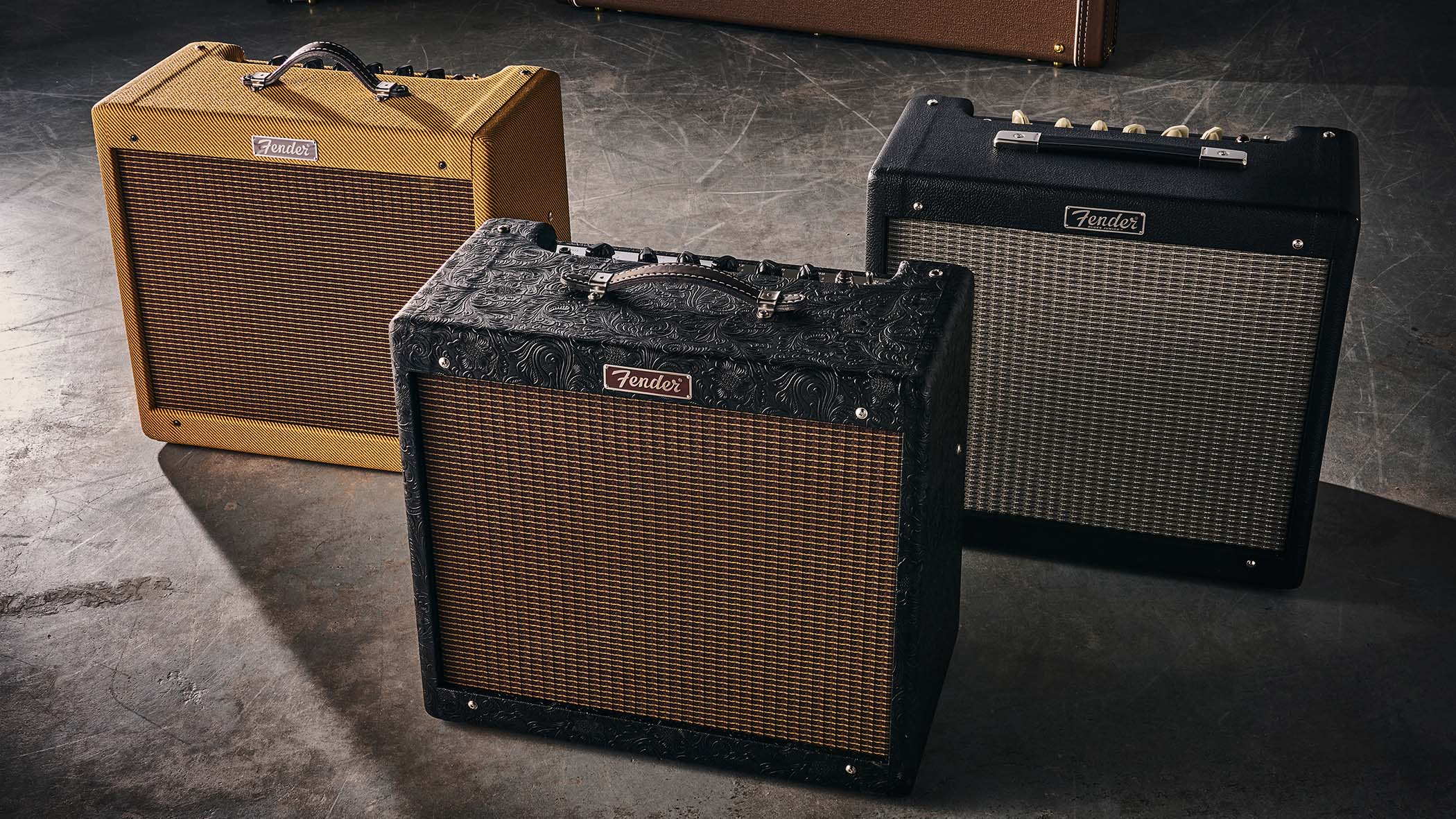How LA ‘junk’ luthier Reuben Cox’s rubber bridge innovations redefined the sound of indie guitar
His instruments are beloved by Phoebe Bridgers, The National and Jackson Browne. Now, the Old Style Guitar Shop owner joins film-maker Alice Gu to discuss their forthcoming documentary on his unconventional builds, Really Good Rejects

LA guitar store Old Style seems to exist in its own world – one far removed from the online stores and mega-marts, or even the rarefied air of vintage specialists. It has become an unassuming home for guitarists who prize personality. A place for oddballs and curios, in more ways than one.
Inside you’ll find walls packed with the weird and wonderful. Revamped Japanese acoustics from the '70s, customized catalog guitars and other assorted junk – from old furniture to Home Depot scraps – that owner Reuben Cox has salvaged and assembled into special instruments.
They are often equipped with electronics and/or piezo pickups, as well as what has become Cox’s calling card: the rubber bridge. He jokingly describes the transformations as “the proletarian miracle” – a process of restoring unloved instruments and putting them in the hands of real players for reasonable prices.
And the players love him for it. Over the years, everyone from The National to Phoebe Bridgers and Jackson Browne have sought out Old Style, mostly in pursuit of the unique and beautiful tone wrung from those rubber bridge builds. His instruments have permeated indie music, passing through the hands of the world’s biggest artists and cropping up on albums from the likes of Bob Dylan, The Rolling Stones and Taylor Swift.
Cox has remained a humble, self-effacing type, but now he’s the subject of a documentary by director and cinematographer, Alice Gu. The film – bearing the supremely appropriate title, Really Good Rejects – explores the shop and the guitars, but also goes much further down the rabbit hole.
Gu’s interviews with Cox and a stellar line-up of artists – among them Aaron Dessner, Carrie Brownstein, Andrew Bird, Jeff Tweedy, Phoebe Bridgers and Jackson Browne – ponder our long standing relationship with the guitar, and dissect the nature of artistry in a playful, imaginative way. As Gu tells us: “It's about magic, for lack of a better term, because that's what it is.”
We spoke to Gu and Cox about Really Good Rejects, Cox’s builds and, of course, the rubber bridge tone that has become the defining guitar sound of indie music in the 2020s.
All the latest guitar news, interviews, lessons, reviews, deals and more, direct to your inbox!



Alice, how did you find out about Reuben and Old Style, and why did you think it warranted a documentary?

Gu: “I’ve been friends with Reuben and his wife, Miwa, for a number of years. I had known about Old Style for a long time and when Miwa would talk about it, I was like, ‘Oh, that's cool. Her husband tinkers with guitars.’ I had no idea of the skill and the artistry that you had, Reuben, until last summer.
“I realized Reuben's guitars have graced Bob Dylan albums, and were used by Andrew Bird and Wilco. But more than that, I really had no idea about this rubber bridge. I saw [guitarist and producer] Blake Mills post a video of him noodling on a rubber bridge guitar, and I couldn't get enough of the sound. I listened to it over and over again. I had to know more and that's when I said, kind of half-jokingly, ‘I should do a little minidoc about Reuben…’”
A film solely about Reuben’s rubber bridge guitars might be a hard sell to the non-guitar player, but Really Good Rejects is about much more than that. You have names like Jeff Tweedy, Jackson Browne and Phoebe Bridgers, among many others, discussing playing, writing and artistry. When did you realize it was beyond the scope of a quick Q&A?
Gu: “It was as soon as we started talking, and I basically said, ‘Can you put some feelers out and see who might want to speak about Old Style?' And, as a testament to Reuben and how fond people are of him and his instruments, everybody came forward and was like, ‘I want to talk about Reuben!’
“Then, as we were speaking about the guitars, we got deep into the weeds and I became fascinated that we all have that Star Wars kind of thing – a force – a tone and energy [that feeds into musical creativity]. It was like this tone of the rubber bridge had to make its way into this world and touch people, and Reuben was the one to midwife the sound! Then these artists picked up on that tone, and it inspired them. More than one person had said, ‘These are Excaliburs’, like the sword in the stone.”
Reuben, from your point of view, what did you hope for from participating in the film?
Cox: “I didn't know what to expect, but I trusted Alice wouldn't make it boring. It just seemed so weird to be the subject of a documentary film.
“But shortly thereafter, the guy in the film who's listed as ‘Mark – Hunter Gatherer’, showed up – as he does in the film – with his Sprinter van loaded [with old guitars and miscellaneous instruments]. And I'm thinking, ‘This could be interesting in a documentary.’ Instead of talking about where stuff had been, here’s this guy who looks like the mad scientist from Back to the Future.
“LA is a repository for interesting musicians so I started slowly connecting Alice with people, and it unfolded in a very interesting and effortless way. At least for me – I mean, there was a lot more effort on Alice's part!”
Gu: “I’ll say it was easy and hard! I was very cognizant of not wanting to make an infomercial piece, and there were so many times were I was like, ‘This is such a sound-good soundbite, but I'm not going to stick it in there.’ Like Phoebe Bridgers saying the first time she used Tony Berg's [rubber bridge] guitar at Sound City, she couldn't get out of there fast enough. She was like, ‘I just had to immediately go to Old Style and get a guitar,’ which I thought was incredible.”

Reuben, how do you decide what instruments to take on and revamp?
Cox: “I guess I’ve been restoring this ‘junk’, as it were, for long enough to know when something is not worth investing a few hours or more into. For instance, doing neck resets on certain classical guitars is too much. But I'm pretty good about trying to take this stuff [and do something]. People like Mark, and others I deal with, are a reliable source for donors for the rubber bridge guitars, as well as interesting '70s Japanese acoustic guitars that I can spend 30 minutes on dialing in to sell to an amateur, you know?
“It means it’s like $350, so a teenager or someone with no money can get something that's cool and vintage-y, and that sounds and plays great. It's always nice to have a trophy guitar that you sell for a profit and make a lot of money on, but over the years the shop has amassed that [broader] type of clientele.
For me, it's much more thrilling to have some teenager spend $300 on what is their first guitar, or to make a guitar and go see someone perform live with it
Reuben Cox
“Sometimes I'll go into other guitar shops and there's this wall of pre-CBS Fenders and I'm like, 'Where the fuck did you get that shit? I want some of that!’ But once you get to a certain level of high-endedness, it attracts a different clientele, which is oftentimes non-musicians buying instruments as lap animals. That is totally fine, but for me it's much more thrilling to have some teenager spend $300 on what is their first guitar, or to make a guitar and go see someone perform live with it.”
A lot of your reputation revolves around the tone of your rubber bridge builds. That idea was first sparked after you heard Blake Mills’ rubber bridge banjo at Sound City. Why do think it stuck with you?
Cox: “I don't know if it would be an epiphany, but it was definitely like, ‘Oh, this is a great moment,’ seeing Blake Mills playing this banjo with a primordial rubber bridge on it. That night, he sent me some pictures and the next day I assembled some random parts and my daughter, Rowan, and I jumped in the car and drove that guitar over to Blake. He started playing it and those videos on Blake's Instagram – from, I guess, 2016 – feature the very first rubber bridge guitar.
“People have been dampening strings by various means [for years]. But the rubber bridge, as it exists now, I think is better because the mute is the bridge, so it integrates way better with everything else. If you put foam in front of the bridge, it makes everything intonate sharp, but string-to-string feel is very uniform [with a rubber bridge].”
A post shared by Blake Mills (@blakemills)
A photo posted by on
Blake Mills obviously enjoyed his first guitar, but did you realize right away that it might have a wider appeal?
Cox: “I knew it was a thing but I never really promoted it. Mostly, I would just put them in the shop and then people would gravitate towards them. Then I just kept slowly building more and people really connected with them.
“But from the beginning, with that first one for Blake, I thought, ‘Well, this will be an R&D thing.’ Because he likes running down something until it's as good as it can be. There were further iterations of that guitar, where we changed the pickups and the strings, but essentially it was there from the beginning.
“Then it percolated through friends of the shop and people who could wrap their mind around it. Or there would be people who would be evangelizing them, like Ethan Gruska. Many times, people would come from either Ethan Gruska's studio or Tony Berg's studio directly to the shop and buy one.”
I really liked the animation elements you incorporated to the film, Alice, particularly in how you explained the resonance and space left in the mix with rubber bridge instruments.
Gu: “I felt like we needed it to contextualize things. One of the most important lines in the film was Mike Viola when he does the little compare and contrast moment, where he plays an acoustic and he's like, ‘This one sounds like country pickin’, and then he switches to the rubber bridge guitar, and he's like, ‘And this is Escape from New York…’
“You really get it: you can hear the difference. I wanted to illustrate it so that people who aren't guitar nerds won't get lost. The beauty in it is the simplicity of the innovation but it sounds so fresh. Ethan Gruska was so poetic in the film. He said the first time he heard it, ‘It took him to the woods.’”
Cox: “Blake mentions [in the film] that it introduces more negative space. Where you have a full-bodied acoustic guitar, if you're looking at the waveform, it would be gobbling up all this midrange. But with the rubber bridge, the decay of the note comes really quickly. If you've got a lot going on in the track, there's so much more sonic real estate for other instruments to to build in. It's very mixer/engineer-friendly.”

Your instruments have passed through the hands of some of the biggest bands in the world now, whether it’s your rubber bridge mods or the custom builds you did for The National early on. What has brought you the most satisfaction?
Cox: “For me, it’s the times when Mark, the guy in the Sprinter van, shows up, I buy a bunch of stuff and it'll be on the shop floor, and I'm like, 'I paid $3,000 for that pile?!' Then I do all the work and once it's done, and you see someone get excited about it, you’re like, ‘Oh, that was worth the effort.’
“Or, Mike Viola wrote this song The American Egypt [the title track of his 2018 record], which appears in the film. He picked up the guitar and instantly played the riff and was like, ‘I’ll take it.’ That song was written immediately – or the primordial ooze for that. So there's satisfaction in there.”
Are there any guitars you've built or restored that you've decided to keep for yourself?
Cox: “Absolutely not! The only the only piece of gear that I have and covet is a 1965 Fender Princeton Reverb amp that I've had since I was 16. It just sounds great, but it's also my yardstick, as it were. I can plug any electric guitar into it and I can tell if the pickups are high output, low output, or whatever. It's like a reference tool for me. That's really the only thing I'm attached to.
“There are other things that linger. I'm much better at selling cheap instruments than expensive ones, so occasionally I'll Forrest Gump myself into a nice instrument. Like, I got a 1947 Martin 000-28 recently and a 1960 [Fender] Jazz Bass, the first year for a Jazz Bass. Both are worth a shitload of money, but I have no idea who to sell them to!”
Carrie Brownstein describes you as part of a small trend of luthiers building with musicians in mind, presumably as opposed to being led by price points and materials. What’s key to that approach?
Cox: “From my experience, it's something that evolved as people come into the shop and I tinker on their instruments. At some point, you're able to speak in a sort of shorthand with them and it becomes intuitive. Whereas if there was a musician that you had admired [from afar], and it was your goal to place something in their hands… they're not always bull’s eyes.
“It is interesting [what appeals to musicians]. Going back to Blake, when he bought the first one – which was made out of plywood from Home Depot – he was working with Don Was and the Rolling Stones. But he says [in Really Good Rejects], they were kind of all huddled over it, like animals on the Serengeti, picking over a dead Ibex or something!
“I’m sure over the years people have said, ‘I’m going to make this guitar for Keith Richards to play and it's going to have the most exotic hardwoods and gemstones and gold leaf and it's gonna have all these select [components]…’ And then there's this guitar that's made out of, like, cast-off parts and it's just kind of trash [but it got them interested]. It just cracks me up.”
I’ve heard many musicians discuss the fancy instruments they bought with their first big paychecks only to find they’re unable to write or gig with them.
Cox: “I think also, maybe in a subliminal way for the artist, it makes them realize that it’s them operating this thing. A 1952 Telecaster is undeniably great and worth a shit-ton of money. But if you have something that's a few hundred dollars or something, and the song pours out of it, it reaffirms your faith in yourself as an artist.”

It seems like Really Good Rejects (and Old Style’s success) taps into some wider ideas, too: whether it’s reassessing the things we regard as waste or understanding the need for physical touch in a virtual era.
Gu: “Yeah. One of the curiosities that I leaned into with the film is the idea that whether we're all in a Metaverse or Google Glass and Oculus and whatnot, we're still these cave people at our core. I was hoping the takeaway from this film was that despite people’s worries about bills and if they get enough likes, they can get lost for 90 minutes and get in touch with their own human-ness.
“The first guitar, I think, was from the 1500s in Spain. The guitar is still essentially six strings on wood, and I think it's beautiful that something has existed for centuries still connects with us – and reminds us that we are humans.”
- Visit the Really Good Rejects website to keep an eye out for the film's general release date.


Matt is Deputy Editor for GuitarWorld.com. Before that he spent 10 years as a freelance music journalist, interviewing artists for the likes of Total Guitar, Guitarist, Guitar World, MusicRadar, NME.com, DJ Mag and Electronic Sound. In 2020, he launched CreativeMoney.co.uk, which aims to share the ideas that make creative lifestyles more sustainable. He plays guitar, but should not be allowed near your delay pedals.
